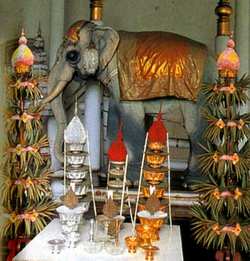Chang Ton Museum (The Royal Elephant National Museum) Since the old days "white elephants" have bee regarded as the symbol of prestige of the king. When the king received such an elephant, he would command a ceremony to celebrate the registration of the elephant as well as naming it Phraya Chang-ton, or Nang Phraya Chang-ton if it was female. The king also had stables for the elephants built in the palace ground. Formerly an elephant stable, this Thai-style building was built in the reign of King Rama V in Dusit Garden Palace compound. The stable was moved into Chang-ton Museum by the Ministry of Education in 1988. The myth and legend of the wite elephant began in Southeast Asia - The Land of the White Elephant. In the story of the Lord Buddha, the white elephant is connected to fertility and to knowledge. On the eve of giving birth to the Lord Buddha, his mother dreams that a white elephant comes to present her with a lotus, symbol of purity and knowledge. The white elephant is something above an ordinary elephant. In Thailand the white elephant is sacred and revered. Indeed, they put the white elephant on their new flag. When elephants were no longer so vital for warfare, elephant hunts had become less common, and fewer of the rare white elephants were found. The Siamese king passed a law demanding that any white elephant found in the kingdom had to be presented to the king. He sent out scounting parties and offered rewards. The discovery of a white elephant became a special event, a time for national celebration.
|
| Hua Hin Accommodation | Rent Hua Hin | Hua Hin Deals | Hua Hin Property | Hua Hin Expat | Hua Hin |
| Hua Hin Apartments | Hua Hin Condos | Hua Hin Villas | Hua Hin Houses | Hua Hin Vacations | Hua Hin Beach |
| Bangkok Hotels | Thailand Hotels | Thailand Travel | Thailand Pictures |








